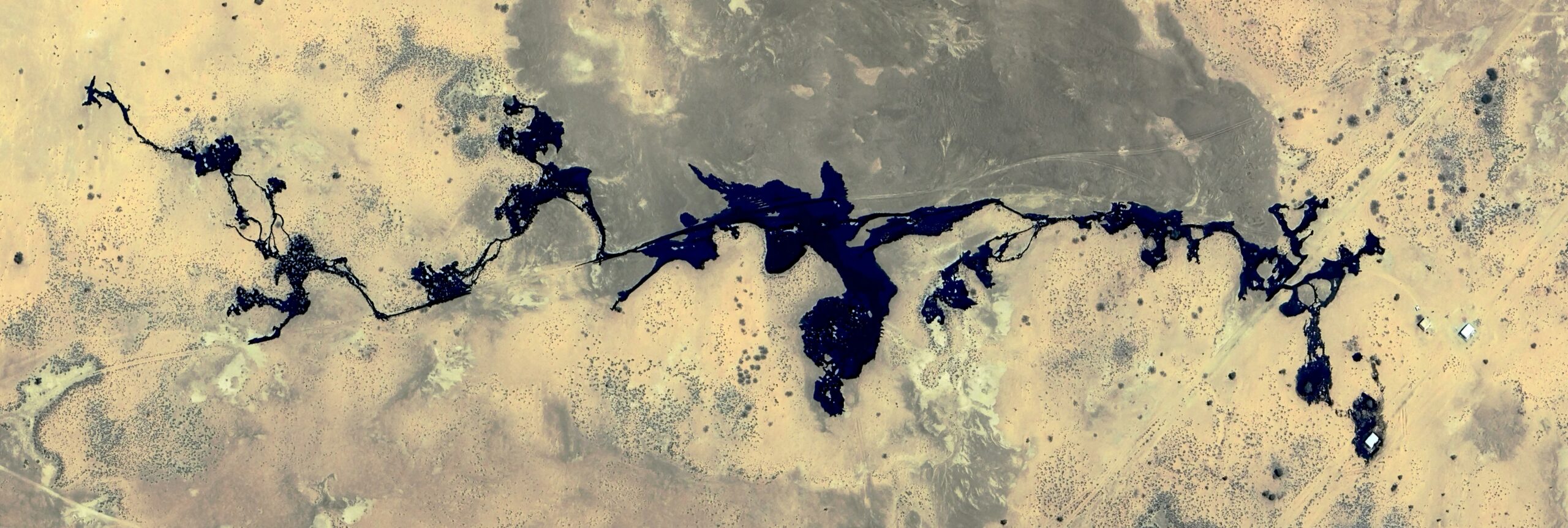Environment, Peace, and Security Implications from the War in Sudan and Spillover Effects on South Sudan
Large smoke plumes blackened the sky over Khartoum with intense shelling of the airport that hit locations storing fuel, including aircrafts, and tankers in April 2023. As the war intensifies over the following weeks and months, so does the human toll of the civil war in Sudan. The ongoing fighting throughout the country has led to large numbers of civilians being killed and wounded, massive displacement, and has been described by the United Nations Special Envoy as ‘hell on earth’. The use of explosive weapons in populated areas in Sudan is worsening civilian suffering and damaging vital water infrastructure and services that people depend on. Ongoing monitoring from groups such as Centre for Information Resilience (CIR) and the US-led Conflict Observatory is demonstrating the severity of the humanitarian impacts and specific urban or rural destruction caused by the fighting.
Many remember the collective hope of 2019 as citizens took to the streets to call for a peaceful transition of power from the previous regime to a civilian-led administration. But with the start of the fighting between the Sudanese Armed Forces, led by Abdel fattah al Burhan and the Rapid Support Forces under control of Mohamed Hamdan Dagalo, known as Hmedti, the country plummeted into another bloody civil war, with other armed groups such the Sudan Liberation Movement and the Sudan People’s Liberation Movement-North joining the fight. The current conflict not only impacts Sudan as a whole but has larger regional security risks as damages to Sudan’s oil infrastructure is leading to a serious socio-economic crisis in the neighbouring South Sudan, that depends on crude oil exports flowing through two large pipelines towards the Port of Sudan.
On March 16th, 2024, Sudan declared a ‘force majeure’, after fighting and maintenance issues resulted in an oil spill and clogged oil pipelines roughly 100 kilometres south of Khartoum, largely halting all oil exports through the Port Sudan oil Petrodar pipeline from the Melut oil fields in the northeast of South Sudan. This pipeline is responsible for 60-70% of South Sudan’s oil exports, making this a vital lifeline for export revenues. Though some exports have since resumed through the Greater Nile Pipeline that is connected to the Unity oil fields in the central north of South Sudan, this incident and its potential fall-out underscores the fragility of the fossil fuel industry in warzones and its broader environmental security implications. In particular in contested border areas such as Abyi, several armed groups are aiming for control over the oil fields, which can spark further border conflict and lead to the potential involvement of the South Sudanese armed forces. The diminishing oil revenues will have serious implications for the political stability in South Sudan, and in the long term, the crumbling fossil fuel infrastructure will bring additional environmental risks to both Sudan and South Sudan.
With the war raging on, in particular around oil fields, and wider implications from pollution, agricultural decline and mass displacement, several Sudanese groups and experts are already calling for an environmental assessment of the war and the implications for public health by setting up the Sudan War Environmental Consequences Observatory (SWECO). This promising initiative should support rapid identification and monitoring of conflict damages with the aim to ‘restore and protect the environment, address social challenges and promote sustainable development in post-war contexts’.
In this research blog PAX will provide a brief analysis of the political and environmental implications of the war on Sudanese and South Sudanese oil infrastructure and put forth recommendations for addressing these concerns for all stakeholders. This analysis is built upon open-source data collection conducted in collaboration with the Center for Information Resilience (CIR) and satellite imagery from relevant affected locations provided by MAXAR, Planet, NASA and the European Space Agency.
Key Points
- Massive fires and localised pollution resulting from targeted attacks on the Khartoum refinery and other fuel storage facilities in and near the city by all warring parties, that is affecting oil production.
- Other oil facilities and pipelines in Sudan under the control of both the Rapid Support Forces and Sudan Armed Forces are attacked, resulting in localised environmental damage and the burning of large volumes of fossil fuels from storage tanks or oil wells.
- Numerous oil spills along the main Greater Nile and Petrodar oil pipelines running from the Sudanese and South Sudanese oil fields towards the main refinery and Port of Sudan oil terminal as a result of improper maintenance and oversight. This is causing localised environmental pollution from crude oil contamination that could affect soils and nearby ecosystems.
Risk of both increasing political instability and environmental crisis in South Sudan following the shutdown of the Petrodar Pipeline, which pumps oil from South Sudan to the Port of Sudan, by the RSF, on March 16th, 2024. Unconfirmed reports indicate interest in the potential construction of open-air oil pits in South Sudan’s oil pits for temporary storage of crude oil, in the absence of proper oil tanker farms. If this will be implemented, there are serious concerns over the safety of those constructions and the potential environmental risks they pose in a region faced with worsened flooding.
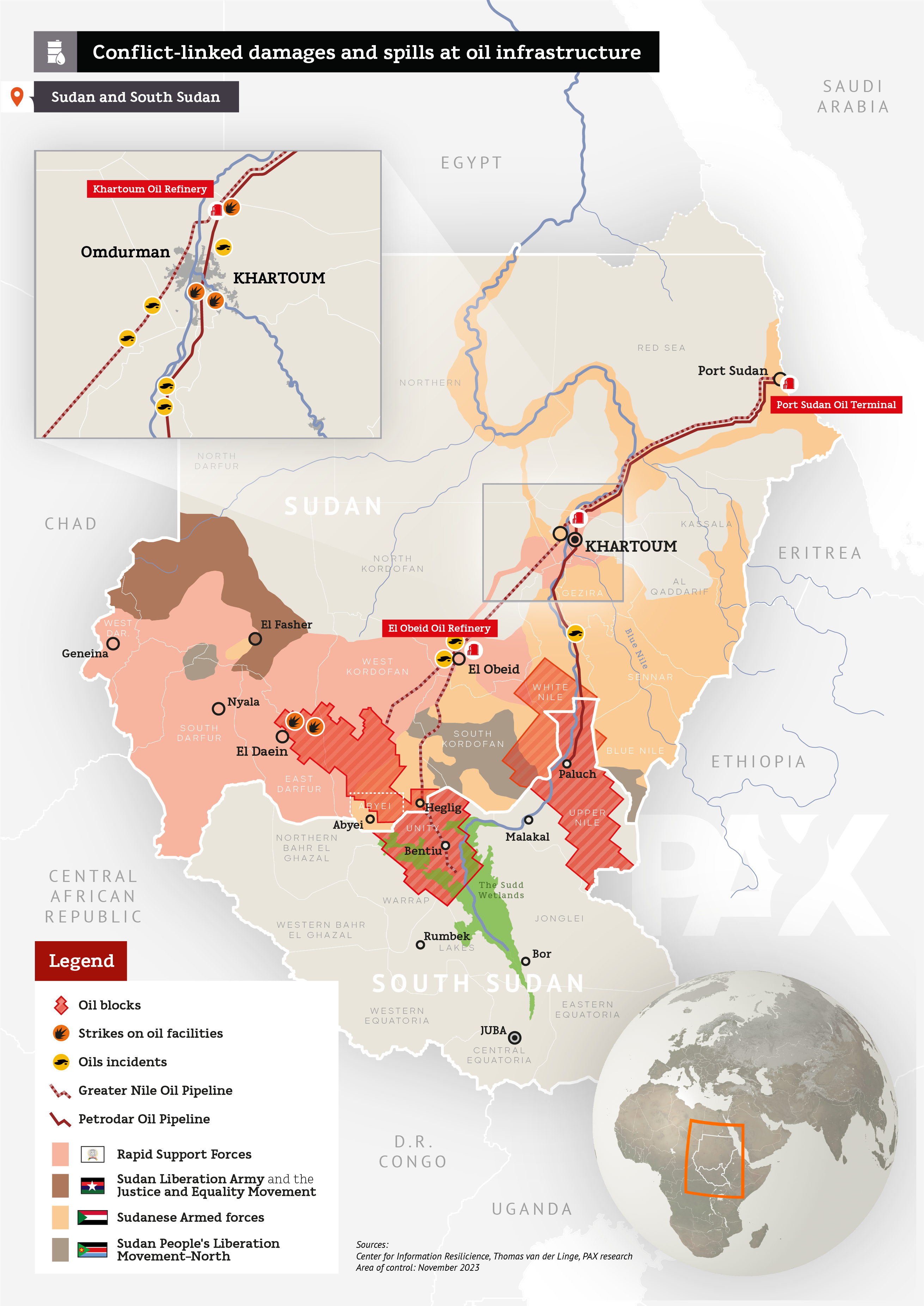
War and Sudan’s Fossil Fuel Industry
The intense fighting taking place in both rural and urban environments and associated attacks on and damage to fossil fuel infrastructure not only have massive humanitarian impacts but also come with wider public health and environmental concerns. Both warring parties seek to control key pipelines, pumping stations, and refineries. When they are unable to gain control, they target these locations to prevent the opponents from effectively making use of the oil production and its revenues. At the same time, the war itself leads to a lack of infrastructure maintenance, resulting in oil spills throughout the country.
As an oil producer, Sudan is a small player in the global market, with a production capacity of roughly 60.000 barrels per day from the oil fields in the south of the country. Sudan already lost 75% of its oil revenue following the Independence of South Sudan in 2011 The main oil blocks are primarily located in Western and Southern Kordofan [Blocks 6, 2 and 1a], with some minor oil exploration going on in Southern Darfur, [Block 6], and the Blue and White Nile governorates [Block 7]. Oil exports bring in an estimated $320 million dollars in annual revenue, with additional revenue of between $300-400 million dollars arising from an agreement with South Sudan, as in-kind payment for oil transit fees. Three large pipelines transport the crude oil to the Port of Sudan, with a total of 3,700 km of pipeline running through the country. The first is the 1510 km long Greater Nile Pipelines (GNP), running from oil fields in South Sudan’s Unity State, also connecting to the Heglig oil fields in the south of Sudan, making this the longest oil pipeline in Africa. The second is the West Nile or Petrodar pipeline, transporting oil from the Melut Basin in the Upper Nile States in South Sudan, with a length of 1472 km. Lastly, the Petroenergy pipeline from Block 6, connecting with the GNP, has a length of 716 km.
Sudan has two main refineries for crude oil processing for the domestic market. For the southern oil fields, the El Obeid refinery in Kordofan, with a capacity of 15.000 barrels a day, mainly produces gasoline and heavy fuel oil for industrial machinery. North of Khartoum is the Khartoum Refinery Company, also known as the Al Jili Refinery, with a capacity of 100.000 barrels a day, and half owned by the Sudanese government and the China National Petroleum Corporation (CNPC). There is still also the decommissioned Port Sudan refinery south of the city, and the large oil tanker terminal at the centre of the port used for the storage and export of crude oil.
Prior to the outbreak of the conflict, there were already widespread environmental issues stemming from weak environmental oversight and enforcement of regulations. The oil field exploration itself resulted in severe forest loss to clear areas for oil drilling, while there were documented structural issues in recent years from lack of maintenance and dumping of wastewater. The resulting pollution of water sources and soils from spills raised public health concerns among affected communities.
Fanning the Flames: Attacks on Oil Infrastructure
During the opening week of the battle of Khartoum, artillery strikes targeted multiple aircraft on the airport tarmac, the adjacent administrative buildings, and several kerosine fuel trucks that all went down in a blaze. Ongoing battles in and around the city also damaged industrial facilities and resulted in burning fuel tanks at several locations in the Yarmouk industrial district, including the Sudanese Petroleum Pipelines Company and nearby smaller tanks storing flammable material. South of the city, shelling hit the Savola Oil Company, causing a fire in some of the tanks storing fuel, while RSF troops were quick to take over key oil infrastructure east of Khartoum. The humanitarian situation worsened as strikes also hit Water, Sanitation and Health Services (WASH) infrastructure, limiting civilian access to clean water, as documented by Human Rights Watch and ACAPS.
The RSF moved quickly after the outbreak of the fighting in April 2023 to take over the Al Jilili refinery north of Khartoum, a key asset for oil revenues and holding control over the income from South Sudan’s crude oil exports. Yet, the refinery also ended up in the crosshairs of the SAF. Repeated strikes hit the refinery from November 2023 onwards, according to the RSF, though the SAF claims there were also multiple incidents due to the lack of unskilled personnel. The attacks by SAF stepped up in May 2024, with some initial damage to pipelines reported on May 21, and airstrikes on May 22 that resulted in several large oil tanks being hit, causing a massive fire that burned for days, with intense air pollution seen on optical imagery and air pollution sensors.
According to the Sudanese oil minister, the country lost over 210,000 barrels of crude oil as a result of the damages and would need $5 billion dollars for recovery of the oil sector. Satellite imagery analysis by PAX shows that at least 27 crude oil, LPG, and refined products tanks on site have been destroyed and more are likely rendered non-operational.
The combined attacks on the refinery in the period November 2023 to February 2024 caused massive fossil fuel burning, igniting four 210,000-barrel capacity crude storage tanks, while airstrikes in May 2024 caused two other large oil tanks to completely burn down, resulting in a massive fire that burned for two days and was visible on satellite imagery. At least 20 smaller tanks of crude oil and refined products were also damaged and destroyed at the refinery since the oil facility ended up in the cross hairs, though the exact fuel amount stored at impact is unclear. Remote sensing data from the ESA Sentinel-5P Tropomi sensor analysed by PAX shows a flare-up of nitrogen dioxide (NO2) in the atmosphere after strikes that hit the larger oil depots, while new research indicated that overall NO2 pollution levels in Khartoum and from the refinery sharply decreased due to the massive displacement of people out of the city, factory shutdowns, and reduced traffic.
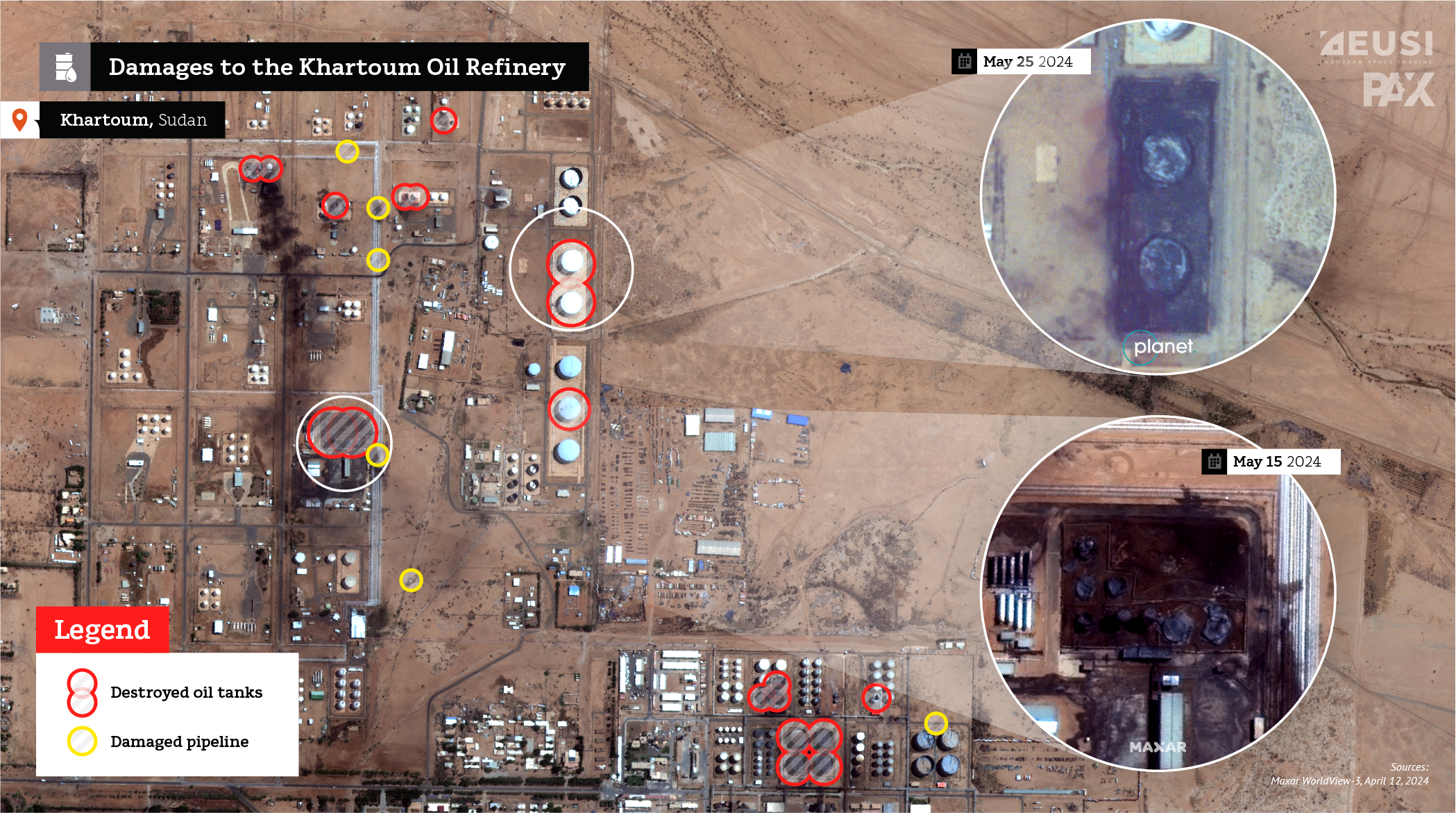
In the south of Sudan, open-source research by CIR and remote sensing data confirmed damage to oil facilities in the Sufyan oil field due to fighting around oil fields in Darfur. Another issue that contributed to the increase of oil spills, is the absence of skilled personnel and maintenance. This allegedly resulted in spills at oil fields, as was noted online by people posting images of an oil spill at the Jake oil fields in South Kordofan, though this could not be verified with satellite imagery. The RSF captured several oil fields in Darfur in early November 2023 from the SAF. The fight for control damaged at least three fuel storage tanks at the Sufyan oil facilities. In late November, RSF forces also took over the Billa oil Central Processing Facility in southern Kordofan, telling engineers to continue their work and ensuring their control over the fossil fuel industry.

At the oil fields in East Darfur, other incidents were reported from spills and subsequent burning of oil. On April 22nd, a local spill was visible on Planet imagery at one of the oil extraction sites at the Zarqa Um Hadid oil field, with NASA VIIRS and optical imagery from early May confirming a fire on site, as well as social media footage showing an ongoing fire at the specific locations. According to the Sudan Post, unidentified persons set fire to one of the largest oil extraction points, causing the blaze. However, as stated earlier, satellite imagery indicated that there was already a spill that occurred at the site in April 2024. High-resolution imagery from Airbus from April 11th, 2024 before the fire shows ongoing activities at this location, making it a potential target for criminal groups. Further information is needed to confirm the cause of the fire and who is responsible.
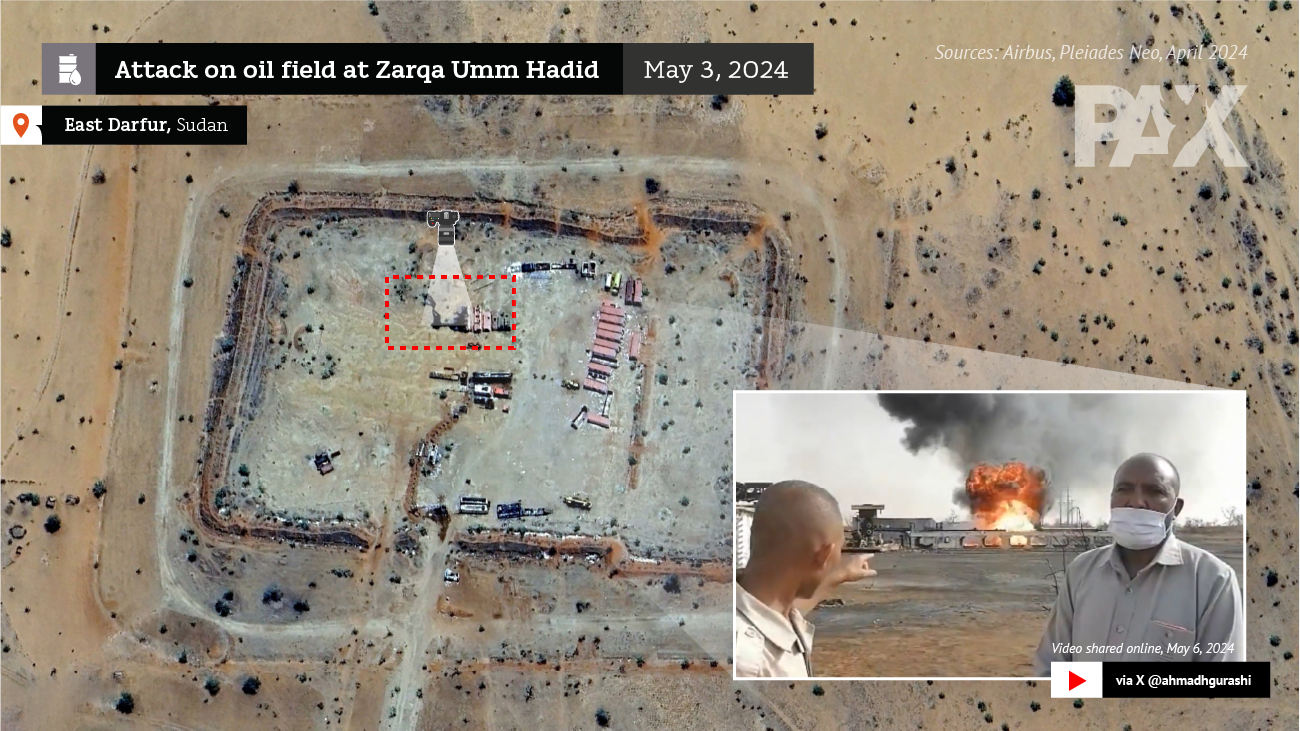
Oil spills and open-air oil pits
With reduced oversight and control from security forces, it is expected that individuals and criminal groups will tap into the oil lines, often with limited technical know-how which can result in spills. With the use of open-source reporting and earth observation data from the ESA Sentinel-2 L2A and NASA Landsat-8 optical sensor, the pipelines were scanned and at least six small and larger spills were found along the main oil pipelines from Kordofan and the South Sudan oil fields to the Port of Sudan, and two cases of an open oil reservoir constructed to capture crude oil from the pipeline.
| Location | Coordinates | Time | Type | Source |
|---|---|---|---|---|
| North Kordofan | 13.245861, 30.189753 | June 2023 | Oil Spill at PETCO Oil facility | Sentinel-2 |
| North Kordofan | 15.426722, 32.215840 | August 2023 | 1.8km spill originating at facility Pumping Station | MAXAR, Bluebell |
| North Kordofan | 13.299135, 30.221413 | August 2023 | Small oil spill at pipeline | Sentinel-2, Planet |
| North Kordofan | 15.182119, 31.983846 | November 2023 | Roughly 1km spill from pipeline | Sentinel-2, Airbus |
| White Nile | 14.700172, 32.269815 | February 2024 | Spill at pipeline that caused ‘force majeure’ oil export from South Sudan | Planet, Sentinel-2 |
| White Nile | 14.550992, 32.248933 | April 2024 | Crude oil dumped in open-air reservoir at Bapco Pumping Station No.3 | Planet, Sentinel-2 |
| White Nile | 13.56678, 32.70349 | April 2024 | Small spill at pumping station | Planet, Sentinel-2 |
| Khartoum | 15.83367, 32.72358 | April 2024 | Crude oil reservoirs constructed near the Khartoum Refinery | MAXAR via Bluebell, Planet |
Several spills in northern Kordofan are seen near oil pumpings stations and along the Greater Nile Pipeline, the largest oil spill range over 1.8 km long that started in August 2023 at the pumping station with an unknown cause. South of this location, there was another large spill detected, possibly caused by oil thieves trying to tap into the pipeline, causing a massive 1.5km spill in the middle of the desert in November 2023. Other smaller spills were detected at the oil pipeline northwest of El-Obeid, another oil hub for the oil fields in the south of Sudan, where a small refinery is still operational. These leaks started already in June 2023, and remained relatively contained in and near the location of origin, and seemed also to be linked with either attempted oil theft, or lack of maintenance causing a rupture.


In February 2024, the spill, visible on Planet imagery, and subsequent ‘force majeure’ that stopped the oil export from South Sudan through the Petrodar pipeline also caused a new practice, namely the formation of open-air oil pits. The largest pit is constructed south of the Khartoum refinery, with crude being tapped from the pipeline, and reported on by BlueBell, a group of Sudanese geospatial experts. These open-airs have a current size of roughly 75000m2 of crude oil being stored in unsafe conditions, and new earth walls indicate that the location is still expanding. The satellite imagery indicates that tanker trucks are using the ponds to load crude oil for transport. Similar practices also seem to have started in April 2024 in the White Nile region of Sudan, as seen on Planet imagery.
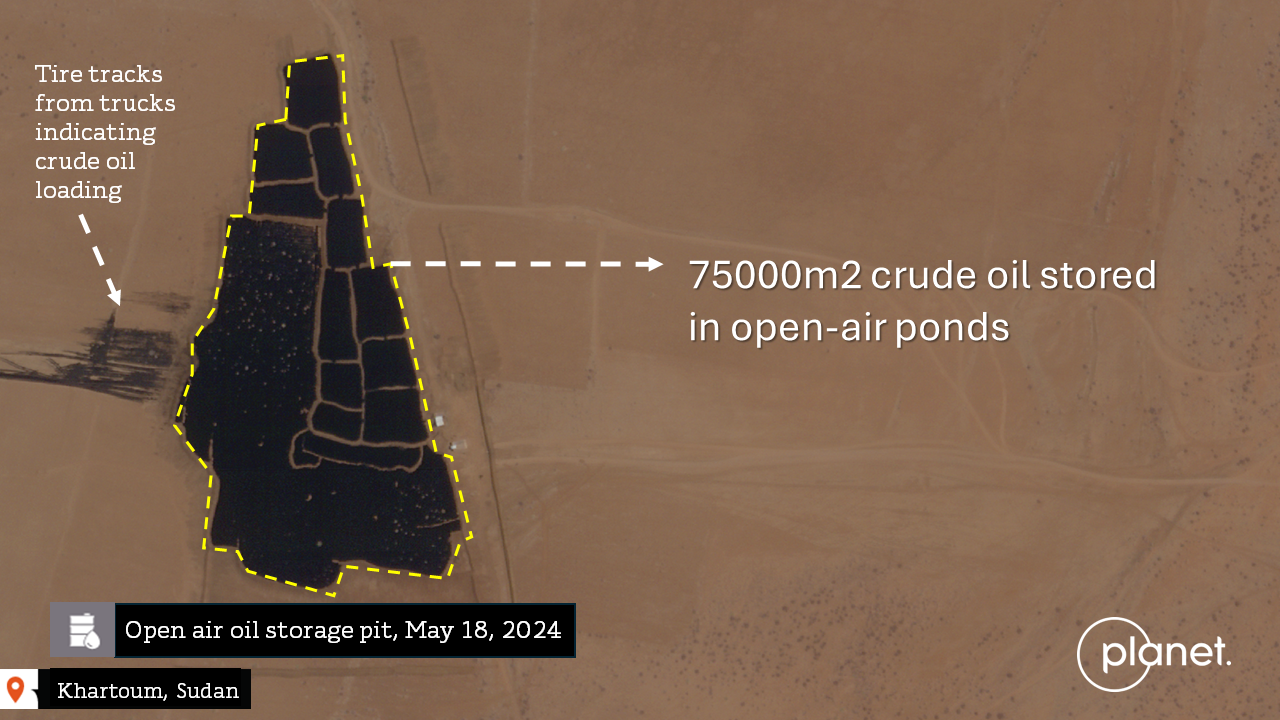
South Sudan’s Halt of Oil Export and Environmental Implications
South Sudan is a large crude oil exporter and its fossil fuel industry has been a source of dispute before the succession from Sudan, including grave human rights violations committed by armed groups with the support of international oil companies to control the oil field, as documented by PAX as part of the work on the oil industry since 2001. The South Sudanese oil industry has an estimated production capacity of 160.000 barrels per day, but dropped to 140.000 in 2023, and has an estimated oil reserve of 5 billion barrels still in the ground. Prior to the political instability in 2013, the country’s oil blocks produced 320.000 barrels per day. The oil revenues are stated to provide more than 85% of the country’s revenues, making this the main source of income for the government, which is using the oil revenues to buy political support and stay in power. The majority of the South Sudanese population does not profit from the oil income and depends on agriculture and pastoralism as a livelihood. The weak governance in South Sudan, especially in the oil industry, also has serious environmental implications. For decades, the oil fields have been a known source of pollution from spills caused by a lack of implementation of environmental regulations, improper maintenance, illegal tapping into oil lines, and other types of accidents. Local environmental groups have long called for a solution to these concerns, but the government’s long-announced environmental assessment, as part of the 2012 Petroleum Act, has yet to be carried out. The environmental and health consequences continue to go unrecorded, as researchers and journalists struggle to access affected areas and face threats, while oil companies withhold operational transparency.
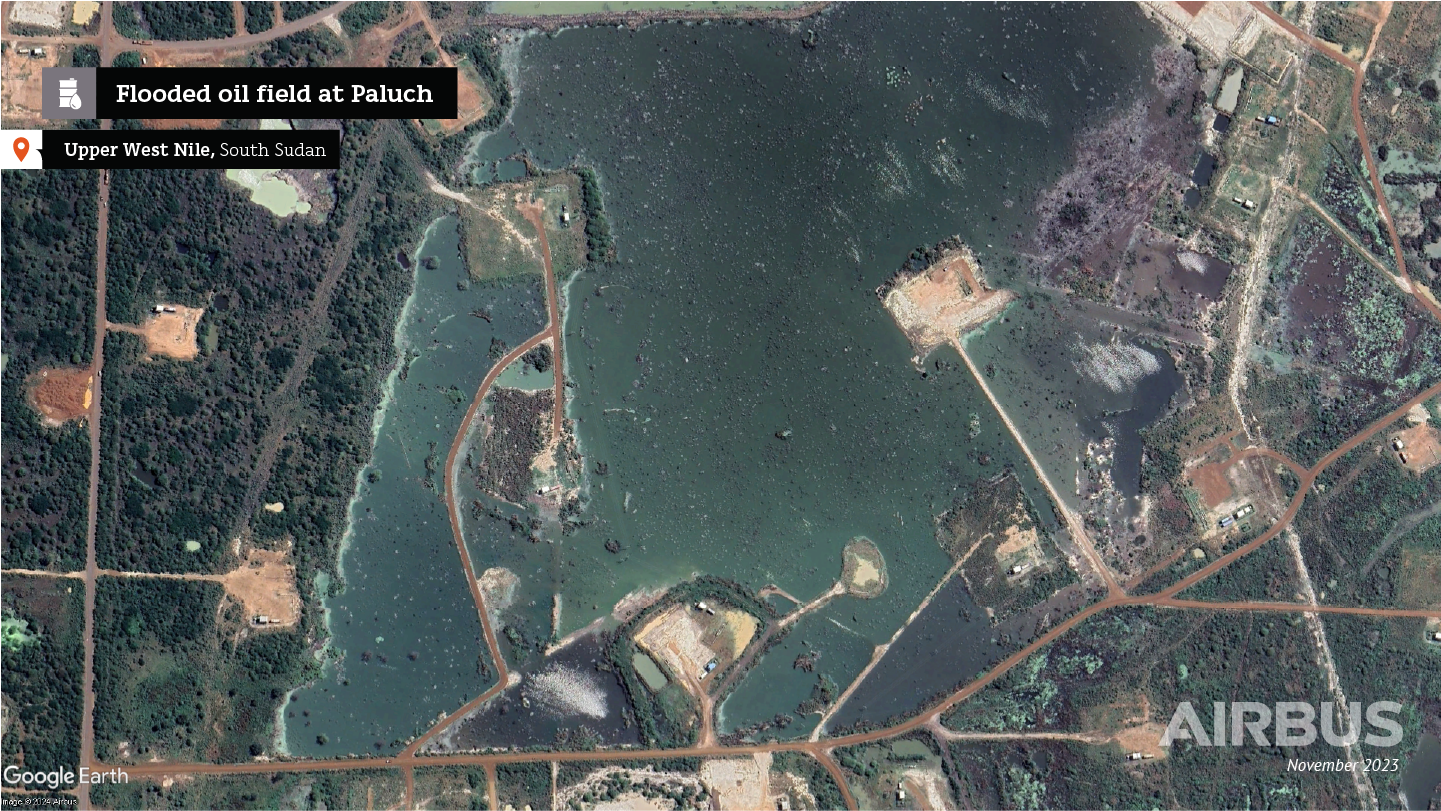
Meanwhile, South Sudan struggles with grave and worsening humanitarian consequences of the seasonal flooding, displacing over 1 million people annually. These floods seem to be getting more erratic and extreme due to the climate crisis. This also has serious implications for South Sudan’s oil infrastructure, as PAX demonstrated with extensive remote sensing analysis in 2023. The findings show that the major oil fields in Unity and Upper Nile State, including oil wastewater pits, chemical storage facilities, and drilling wells are getting flooded. This flooding could contaminate land outside the oil fields, including areas for pastoralists, as well as affected water sources such as drinking wells.
Growing Environmental Insecurity From an Export Shutdown
With the oil export through the Sudan pipeline coming to a halt, South Sudan is now on the brink of a serious political crisis. Oil revenues will cease, leaving the political elite without the financial resources to maintain their political support. As salaries cannot be paid to civil servants, the country could soon fall into chaos.
This crisis also raises a pressing environmental concern: how will this affect oil operations? In the long term, the crisis also raises questions over South Sudan’s fossil fuel dependency. To start with the former, South Sudan does not currently have sufficient storage capacity for the daily extraction of crude oil, but to keep pressure on the oil wells to ensure the continuation of extraction, oil needs to be pumped up. This means the oil industry will run out of storage capacity soon, and will either have to shut down wells, or rapidly develop a plan for, and financing of, safe construction of sufficient oil storage tanks. There are already unconfirmed reports that oil companies will construct a large open-air storage pit for pumped-up crude oil near the oil fields in Unity and Upper Nile State. This could potentially result in a massive environmental catastrophe, in case one of the reservoirs breaks down, considering the weak state of the oil industry and the limited capacity and expertise to carry out such a massive endeavour.
The unpredictability of the increasing and intensifying floods exacerbates the risks posed by these ad-hoc constructions. In case of a rupture or flooding of such an open-air crude oil pit, hundreds of thousands of litres of crude oil could contaminate nearby soil, the White Nile, and the larger Sudd wetland, one of the largest UNESCO-protected areas.
The broader question also strikes at the heart of the ruling class’s fragile fossil fuel dependency. Could this be an opportunity to look for an alternative economic path that leaves fossil fuel in the ground? Some experts have put forward strong arguments to begin this search for alternatives, both in light of reducing fossil fuel extraction and its climate impacts, as well as reducing a resource that is the root of political insecurity, as groups aim to control oil fields for their resources. Most of the population in South Sudan do not share in the wealth from the oil extraction and are largely dependent on humanitarian aid and international loans that foot the bills for basic services in the country. The global call for decarbonisation could be important to start the debate on rearranging the political economy of South Sudan to benefit the population and move away from its dependency on oil exports.
Yet, amidst the current political conditions and state of affairs, analysts predict that South Sudan, alongside Libya and Iraq, is likely to be one of the last countries to phase out fossil fuel extraction. This entails there are hardly any viable alternatives for a sustainable economy away from fossil fuels that provide other income sources. A new $13 billion dollar loan between South Sudan and a United Arab Emirates-based company announced in April 2024 indicates that the government is in search of money using their oil reserves as a guarantee, and the news indicated that South Sudan seeks to build its own oil refinery. This would further weaken its position due to a dependency on fossil fuels and foreign markets.
Preparing for the Day After Tomorrow
With over a year of fighting in Sudan, the environmental dimensions of war in the country and spill-over effects in South Sudan highlight the fragility of fossil fuel infrastructure both as a direct source of pollution and the wider regional environmental security. The findings of this Environment and Conflict Alert demonstrate that direct targeting of oil infrastructure in Sudan created numerous local small and larger oil pollution hotspots while tapping and lack of maintenance of the oil pipelines resulted in at least six oil spills and the construction of unsafe open-air oil reservoirs. Earth observation with the support of satellite imagery and open-source monitoring is proven to be an essential tool for tracking these types of incidents around oil infrastructure. Visualising the consequences is an effective way to raise awareness of the risks associated with fossil fuel infrastructure in times of armed conflicts, while the data can also be used in post-conflict assessment and remediation efforts.
Ongoing monitoring of the oil fields in South Sudan is also needed to keep track of the potential construction of open-air reservoirs, and needs additional remote sensing analysis and meteorological and hydrological modelling to predict the risks if these plans are executed by the government and the oil industry. This analysis is also supporting the recent UNEA-6 resolution 6.12, titled ‘Environmental assistance and recovery in areas affected by armed conflict’ which requested UNEP to develop technical guidance on monitoring of environmental damage related to armed conflicts.
The environmental dimensions of the war both in Sudan itself and the transboundary consequences warrant proper documentation to quantify the potential impacts, highlight risks to public health and ecosystems, and facilitate rapid response and recovery efforts that needed to be addressed when the guns fall silent.
Remote sensing and background research by Wim Zwijnenburg, zwijnenburg@paxforpeace.nl
With thanks to Centre for Information Resilience @Cen4infoRes for their open-source monitoring data, Nadir Hassanein (University of Khartoum Corporation), Kor Puoch (The Sudd Environment Agency) and some reviewers who choose to remain anonymous for feedback, Ariel Ozdemir for editing, Planet for the Skysat images and European Space Imaging for providing MAXAR imagery. Maps and graphics by Frans van der Vleuten

